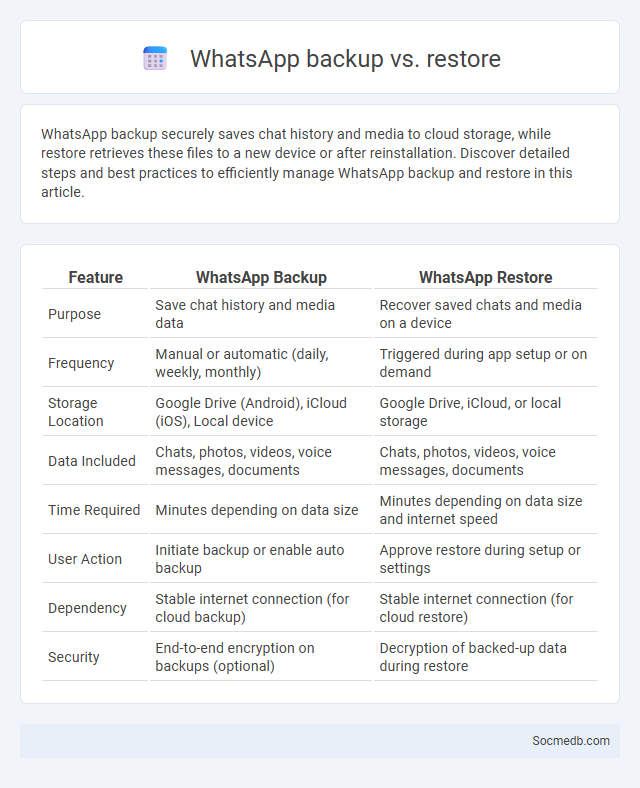
Photo illustration: WhatsApp backup vs restore
WhatsApp backup securely saves chat history and media to cloud storage, while restore retrieves these files to a new device or after reinstallation. Discover detailed steps and best practices to efficiently manage WhatsApp backup and restore in this article.
Table of Comparison
| Feature | WhatsApp Backup | WhatsApp Restore |
|---|---|---|
| Purpose | Save chat history and media data | Recover saved chats and media on a device |
| Frequency | Manual or automatic (daily, weekly, monthly) | Triggered during app setup or on demand |
| Storage Location | Google Drive (Android), iCloud (iOS), Local device | Google Drive, iCloud, or local storage |
| Data Included | Chats, photos, videos, voice messages, documents | Chats, photos, videos, voice messages, documents |
| Time Required | Minutes depending on data size | Minutes depending on data size and internet speed |
| User Action | Initiate backup or enable auto backup | Approve restore during setup or settings |
| Dependency | Stable internet connection (for cloud backup) | Stable internet connection (for cloud restore) |
| Security | End-to-end encryption on backups (optional) | Decryption of backed-up data during restore |
Introduction to WhatsApp Backup, Restore, and Chat Backup
WhatsApp backup allows you to securely save your chat history, including messages, photos, and videos, to cloud storage platforms like Google Drive or iCloud. Restoring your WhatsApp backup ensures seamless recovery of your conversations and media when switching devices or reinstalling the app. Understanding chat backup settings helps you customize backup frequency and storage, protecting Your valuable social media communications from data loss.
Understanding WhatsApp Backup
WhatsApp backup is essential for securing your chat history, including messages, photos, and videos, ensuring they are retrievable if you switch devices or reinstall the app. Backups can be stored locally on your device or on cloud services like Google Drive for Android and iCloud for iOS, with options for auto-scheduling. Understanding your WhatsApp backup settings allows you to manage storage space effectively and maintain privacy by choosing encryption preferences.
What Does Restore Mean in WhatsApp?
In WhatsApp, "restore" refers to the process of recovering chat histories, media files, and settings from a previously created backup, typically stored on Google Drive for Android or iCloud for iOS. This feature allows users to seamlessly reinstate their conversations and data after reinstalling the app or switching to a new device. Restoring ensures continuity of communication by importing saved messages and media without data loss.
Chat Backup Explained: Differences from General Backup
Chat Backup specifically safeguards your messaging history, including texts, images, and voice notes, whereas general backup encompasses all device data such as apps, settings, and files. This targeted backup ensures your conversations remain intact for easy restoration on social media platforms without affecting other device information. Understanding these differences helps you securely preserve your chat history without unnecessary data overload.
Key Features of WhatsApp Backup
WhatsApp backup offers automatic cloud storage of chat history, media files, and voice messages on platforms like Google Drive and iCloud, ensuring data preservation and easy recovery. It supports scheduled backups with encryption for enhanced security and privacy, protecting user information from unauthorized access. Users can selectively restore conversations or entire chats, facilitating seamless migration across devices and preventing data loss during phone changes or reinstallation.
How Restore Works in WhatsApp
Restore in WhatsApp involves retrieving your chat history and media from a backup stored on cloud services like Google Drive or iCloud. This process ensures that your messages, photos, and videos remain intact when you reinstall the app or switch devices. You can initiate the restore by verifying your phone number and following the prompts to restore your backup, maintaining continuity of your conversations.
Step-by-Step Guide to Chat Backup
Backing up chat history on social media platforms like WhatsApp or Facebook Messenger ensures data security and easy restoration. Start by navigating to the app's settings, then select the chat or conversation backup option, choosing between local storage or cloud services like Google Drive or iCloud. Regularly updating backups preserves messages, media files, and contact information, protecting against data loss during device changes or app reinstallations.
Comparing WhatsApp Backup vs. Restore vs. Chat Backup
WhatsApp Backup saves chat data, media, and settings to cloud storage like Google Drive or iCloud, ensuring data security and easy migration between devices. Restore retrieves the saved backup to reinstate previous chat history, messages, and media on a new or reset device seamlessly. Chat Backup specifically refers to the process of creating copies of individual or group message histories, distinguishing it as the foundational step for both backup and restore functions in WhatsApp.
Common Issues with Backup, Restore, and Chat Backup
Common issues with social media backup include incomplete data capture and failure to sync across devices, which can result in lost memories or conversations. Restore problems often arise from version mismatches or corrupted files, causing delays or data loss during the recovery process. To protect Your chat backups, ensure consistent updates and encrypted storage options are enabled to prevent unauthorized access and data corruption.
Best Practices for Safeguarding WhatsApp Data
To safeguard WhatsApp data, enable two-step verification to add an extra layer of security beyond the standard password. Regularly back up your chats to encrypted cloud storage, ensuring your messages and media remain protected in case of device loss or damage. You should also review and adjust your privacy settings to control who can see your profile information and status updates, minimizing exposure to unauthorized access.
 socmedb.com
socmedb.com